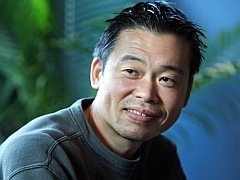I Hate People Who Hate Change
By thebooya 30 Comments
(Reposted from Beefy Media's very own blog)
I was recently perusing the interwebs, searching around for new trailers or information about Bionic Commando: Rearmed 2. For those of you who don’t know, I previously worked at Capcom as Director of Production for three years, leaving recently to start my own company, Beefy Media.
While I was at Capcom, we rallied for and got approved the sequel to our successful XBLA & PSN game, Bionic Commando: Rearmed. I was very excited to work on this project, as I had gotten a chance to work on the original title (albeit VERY briefly).
You see, when I first got to Capcom, I had 2 goals. Goal 1 was to create a sequel to Dead Rising, one of my favorite games of past years. Goal 2 (only slightly behind goal 1) was to resurrect the Bionic Commando franchise. I’m sure you can understand how pissed off I was on an EPIC SCALE when I joined mid-2007 and found out that BOTH of these initiatives were well underway without any of my ideas.
Regardless, I plodded along very happily that both were being made, and after talking to some people internally, heard that Blue Castle and Grin wouldn’t let down the fanbase on these sequels. My next goal was to get my hands on these games to try them out, which for those of you who don’t know, is near impossible in a Japanese company.
So fast forward a year later. Bionic Commando: Rearmed launches (with one of the greatest launch trailers of all time) and ends up selling very well. In 2009, myself, Rey Jiminez, a Producer at Capcom (and the current Producer of BC:R2), and Kraig Kujawa, our Director of Design, embark on a mission to get a sequel to the game made.
Now most people don’t realize that BC:R was almost a level-by-level perfect re-creation of the original. When I first met the development team, they showed me the palette swatches that they had taken the color choices for the game. It was intense… these guys clearly had as much passion for the original as I did back in the day.
 When it came to the sequel, we had many conversations about what we could add. I want to be very clear – NOBODY INVOLVED IN THESE DISCUSSIONS WERE ‘SUIT DOUCHES’. A ‘suit douche‘ is the name that I have awarded to people in the games industry who are empowered to make decisions, but have no idea of what video games are about and ‘played a game or 2 some years ago’. I loathe these types of people, and I assure you we didn’t have any involved in the disucssions. I was lucky at Capcom to work alongside bright, talented, and ridiculously knowledgeable people.
When it came to the sequel, we had many conversations about what we could add. I want to be very clear – NOBODY INVOLVED IN THESE DISCUSSIONS WERE ‘SUIT DOUCHES’. A ‘suit douche‘ is the name that I have awarded to people in the games industry who are empowered to make decisions, but have no idea of what video games are about and ‘played a game or 2 some years ago’. I loathe these types of people, and I assure you we didn’t have any involved in the disucssions. I was lucky at Capcom to work alongside bright, talented, and ridiculously knowledgeable people.
Since BC:R2 was going to be a true sequel, it gave us an opportunity to build from the ground up what a sequel of the original was – rethinking the evolution of the character, the abilities, the environments – everything soup-to-nuts. We had passionate conversations with the BC:R team in regards to changes, suggestions, and improvements. The beautiful thing about it was that EVERYONE was passionate. Whether it was their idea or someone else’s, there was rabid conversation about changes and how we would handle it.
As I reminisce to those discussions, I bring you all around to the reason I’m writing this article. I recently came across an article written by Jeremy Parish aka @Gamespite that decided to make broad assumptions that the people that are making BC:R2 are spineless schmoopties trying to appease modern-day low-ass-barrier-of-entry gamers.
My friend, you couldn’t be FARTHER from the truth.
I read your article thoroughly, and I automatically give you a ton of credit. You are passionate, you are doing what you love, and you have a man crush on the Bionic Commando Franchise. You and I have all of those things in common – when I got my dream job at Capcom, I was (and am still) very passionate about what I do, doing what I loved (making video games FFS) and I had a THROBBING man crush on Bionic Commando.
So that’s why you have to understand that your article, although articulate, was thoroughly assumptive in all the wrong ways.
 To your own admission, you applauded Capcom for evolving the original arcade version of Bionic Commando to the home console NES release. You even mention in your article that “ These small refinements took a concept that was interestingly novel but deeply infuriating in its arcade incarnation and made it completely viable and genuinely fun on NES. Bionic Commando began as a nice idea, but the improvements it saw in its transition to cartridge form transformed it into something unique and very nearly perfect in its execution.” This was due to some of the fundamental changes that Capcom took in the early days from the Super Joe control scheme to the Rad Spencer one.
To your own admission, you applauded Capcom for evolving the original arcade version of Bionic Commando to the home console NES release. You even mention in your article that “ These small refinements took a concept that was interestingly novel but deeply infuriating in its arcade incarnation and made it completely viable and genuinely fun on NES. Bionic Commando began as a nice idea, but the improvements it saw in its transition to cartridge form transformed it into something unique and very nearly perfect in its execution.” This was due to some of the fundamental changes that Capcom took in the early days from the Super Joe control scheme to the Rad Spencer one.
And now we add the ‘jump’ function and everything that is and was Bionic Commando is flushed down the window? How is that so?
Every original game that gets a sequel changes. It evolves. New additions, new storylines, and – SHOCKER – new mechanics.
You facetiously mention that “ A platformer that threw out the jump button was well and good in the heady, experimental days of the ’80s, but in these safe and formulaic times, there’s just no room for it. ” Could it be that the people that made that decision and developed the game are as deeply passionate about the IP as you are? Could it be that we were refining and improving on things just as our forefathers at Capcom 20 years earlier would have? What would you say if I told you that the guys in Japan who had worked at Capcom 20+ years liked the idea? Would that sway you?
 Why do we fear change in video games so much? We always assume that it’s going to ruin the experience. Our industry has evolved in astronomical ways over the past 30 years, and the developers of the game want to “meekly” (as you say) add a new feature, and they are automatically chastised for “ having a petrifying fear of alienating fickle audiences”?
Why do we fear change in video games so much? We always assume that it’s going to ruin the experience. Our industry has evolved in astronomical ways over the past 30 years, and the developers of the game want to “meekly” (as you say) add a new feature, and they are automatically chastised for “ having a petrifying fear of alienating fickle audiences”?
What happened to the olden days where we had to actually PLAY the game before we asserted our opinion? Or maybe reached out to some people on the dev or publishing team to find out if they were simply ‘selling out’ to sell 7 more units?
Instead of asserting that “even our digitally distributed niche games have to compromise for mass appeal when the folks watching the bottom line see that a wire arm as a potential noose around their necks.”, let’s say what we all really feel:
“As a massive fan of the Bionic Commando franchise, I’m super excited for the sequel for BC:R. I know you added jump, and although I’m skeptical, I’m going to buy the game. If it’s shit, I’m going to hop onto the tallest mountain and crap all over it, but before that moment I will assume, much like we did in the olden days, that there are some developers out there that still know what they are doing”.
Sincerely yours,
Adam Boyes
PS – We made it so you can finish the whole game without jumping. Good luck.



Log in to comment